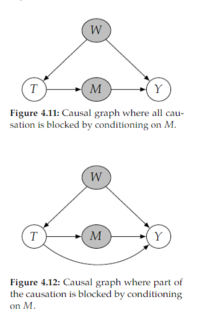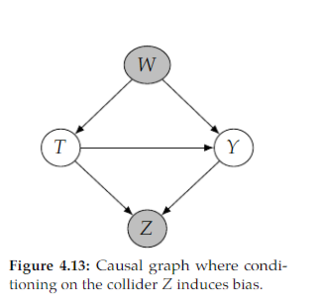Edited, memorised or added to reading queue
on 14-Jun-2022 (Tue)
Do you want BuboFlash to help you learning these things? Click here to log in or create user.
| status | not read | reprioritisations | ||
|---|---|---|---|---|
| last reprioritisation on | suggested re-reading day | |||
| started reading on | finished reading on |
Parent (intermediate) annotation
Open ithe intervention do(𝑡) occurs. For example, 𝔼[𝑌 | do(𝑡), 𝑍 = 𝑧] refers to the expected outcome in the subpopulation where 𝑍 = 𝑧 after the whole subpopulation has taken treatment 𝑡 . In contrast, <span>𝔼[𝑌 | 𝑍 = 𝑧] simply refers to the expected value in the (pre-intervention) population where individuals take whatever treatment they would normally take ( 𝑇 ). This distinction will become important when we get to counterfactuals in <span>
Original toplevel document (pdf)
cannot see any pdfsFlashcard 7093198392588
| status | not learned | measured difficulty | 37% [default] | last interval [days] | |||
|---|---|---|---|---|---|---|---|
| repetition number in this series | 0 | memorised on | scheduled repetition | ||||
| scheduled repetition interval | last repetition or drill |
| status | not read | reprioritisations | ||
|---|---|---|---|---|
| last reprioritisation on | suggested re-reading day | |||
| started reading on | finished reading on |
| status | not read | reprioritisations | ||
|---|---|---|---|---|
| last reprioritisation on | suggested re-reading day | |||
| started reading on | finished reading on |
Flashcard 7095673556236
| status | not learned | measured difficulty | 37% [default] | last interval [days] | |||
|---|---|---|---|---|---|---|---|
| repetition number in this series | 0 | memorised on | scheduled repetition | ||||
| scheduled repetition interval | last repetition or drill |
Parent (intermediate) annotation
Open itIn defining the backdoor criterion (Definition 4.1) for the backdoor adjustment (Theorem 4.2), not only did we specify that the adjustment set 𝑊 blocks all backdoor paths, but we also specified that 𝑊 does not contain any descendants of 𝑇
Original toplevel document (pdf)
cannot see any pdfsFlashcard 7095675653388
| status | not learned | measured difficulty | 37% [default] | last interval [days] | |||
|---|---|---|---|---|---|---|---|
| repetition number in this series | 0 | memorised on | scheduled repetition | ||||
| scheduled repetition interval | last repetition or drill |
Parent (intermediate) annotation
Open itDefinition 3.2 (What is a cause?) A variable 𝑋 is said to be a cause of a variable 𝑌 if 𝑌 can change in response to changes in 𝑋
Original toplevel document (pdf)
cannot see any pdfsFlashcard 7095678274828
| status | not learned | measured difficulty | 37% [default] | last interval [days] | |||
|---|---|---|---|---|---|---|---|
| repetition number in this series | 0 | memorised on | scheduled repetition | ||||
| scheduled repetition interval | last repetition or drill |
| status | not read | reprioritisations | ||
|---|---|---|---|---|
| last reprioritisation on | suggested re-reading day | |||
| started reading on | finished reading on |
Flashcard 7095681944844
| status | not learned | measured difficulty | 37% [default] | last interval [days] | |||
|---|---|---|---|---|---|---|---|
| repetition number in this series | 0 | memorised on | scheduled repetition | ||||
| scheduled repetition interval | last repetition or drill |
Parent (intermediate) annotation
Open itAssumption 3.2 (Minimality Assumption) 1. Given its parents in the DAG, a node 𝑋 is independent of all its non-descendants (Assumption 3.1). 2. Adjacent nodes in the DAG are dependent.
Original toplevel document (pdf)
cannot see any pdfsFlashcard 7095683779852
| status | not learned | measured difficulty | 37% [default] | last interval [days] | |||
|---|---|---|---|---|---|---|---|
| repetition number in this series | 0 | memorised on | scheduled repetition | ||||
| scheduled repetition interval | last repetition or drill |
Parent (intermediate) annotation
Open itIf we condition on a descendant of 𝑇 that isn’t a mediator, it could unblock a path from 𝑇 to 𝑌 that was blocked by a collider. For example, this is the case with conditioning on 𝑍 in Figure 4.13. This induces non-causal association between 𝑇 a
Original toplevel document (pdf)
cannot see any pdfsFlashcard 7095685614860
| status | not learned | measured difficulty | 37% [default] | last interval [days] | |||
|---|---|---|---|---|---|---|---|
| repetition number in this series | 0 | memorised on | scheduled repetition | ||||
| scheduled repetition interval | last repetition or drill |
Parent (intermediate) annotation
Open ithierarchical GAN - Summary There are many ways of dealing with this problem using different levels of granularity. We presented one that can be easily extended to handle temporal sequences. Its main
Original toplevel document (pdf)
cannot see any pdfs| status | not read | reprioritisations | ||
|---|---|---|---|---|
| last reprioritisation on | suggested re-reading day | |||
| started reading on | finished reading on |
| status | not read | reprioritisations | ||
|---|---|---|---|---|
| last reprioritisation on | suggested re-reading day | |||
| started reading on | finished reading on |
| status | not read | reprioritisations | ||
|---|---|---|---|---|
| last reprioritisation on | suggested re-reading day | |||
| started reading on | finished reading on |
| status | not read | reprioritisations | ||
|---|---|---|---|---|
| last reprioritisation on | suggested re-reading day | |||
| started reading on | finished reading on |
| status | not read | reprioritisations | ||
|---|---|---|---|---|
| last reprioritisation on | suggested re-reading day | |||
| started reading on | finished reading on |
| status | not read | reprioritisations | ||
|---|---|---|---|---|
| last reprioritisation on | suggested re-reading day | |||
| started reading on | finished reading on |
| status | not read | reprioritisations | ||
|---|---|---|---|---|
| last reprioritisation on | suggested re-reading day | |||
| started reading on | finished reading on |

